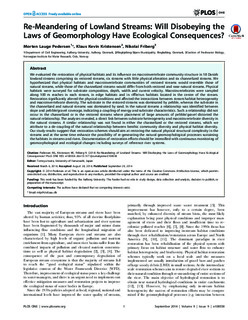| dc.contributor.author | Pedersen, Morten Lauge | |
| dc.contributor.author | Kristensen, Klaus Kevin | |
| dc.contributor.author | Friberg, Nikolai | |
| dc.date.accessioned | 2015-01-05T12:34:47Z | |
| dc.date.accessioned | 2015-01-07T09:21:46Z | |
| dc.date.available | 2015-01-05T12:34:47Z | |
| dc.date.available | 2015-01-07T09:21:46Z | |
| dc.date.issued | 2014 | |
| dc.identifier.citation | Pedersen, M.L., Kristensen, K.K. and Friberg, N., 2014. Re-Meandering of Lowland Streams: Will Disobeying the Laws of Geomorphology Have Ecological Consequences? PLOS ONE 9(9) e108558 | nb_NO |
| dc.identifier.issn | 1932-6203 | |
| dc.identifier.uri | http://hdl.handle.net/11250/273683 | |
| dc.description | - | nb_NO |
| dc.description.abstract | We evaluated the restoration of physical habitats and its influence on macroinvertebrate community structure in 18 Danish lowland streams comprising six restored streams, six streams with little physical alteration and six channelized streams. We hypothesized that physical habitats and macroinvertebrate communities of restored streams would resemble those of natural streams, while those of the channelized streams would differ from both restored and near-natural streams. Physical habitats were surveyed for substrate composition, depth, width and current velocity. Macroinvertebrates were sampled along 100 m reaches in each stream, in edge habitats and in riffle/run habitats located in the center of the stream. Restoration significantly altered the physical conditions and affected the interactions between stream habitat heterogeneity and macroinvertebrate diversity. The substrate in the restored streams was dominated by pebble, whereas the substrate in the channelized and natural streams was dominated by sand. In the natural streams a relationship was identified between slope and pebble/gravel coverage, indicating a coupling of energy and substrate characteristics. Such a relationship did not occur in the channelized or in the restored streams where placement of large amounts of pebble/gravel distorted the natural relationship. The analyses revealed, a direct link between substrate heterogeneity and macroinvertebrate diversity in the natural streams. A similar relationship was not found in either the channelized or the restored streams, which we attribute to a de-coupling of the natural relationship between benthic community diversity and physical habitat diversity. Our study results suggest that restoration schemes should aim at restoring the natural physical structural complexity in the streams and at the same time enhance the possibility of re-generating the natural geomorphological processes sustaining the habitats in streams and rivers. Documentation of restoration efforts should be intensified with continuous monitoring of geomorphological and ecological changes including surveys of reference river systems. | nb_NO |
| dc.language.iso | eng | nb_NO |
| dc.publisher | PLOS | nb_NO |
| dc.relation.uri | http://www.plosone.org/article/fetchObject.action?uri=info%3Adoi%2F10.1371%2Fjournal.pone.0108558&representation=PDF | |
| dc.rights | Attribution 4.0 International (CC BY 4.0) | * |
| dc.rights.uri | https://creativecommons.org/licenses/by/4.0/ | * |
| dc.rights.uri | http://www.plosone.org/static/license | |
| dc.title | Re-Meandering of lowland streams: Will disobeying the laws of geomorphology have ecological consequences? | nb_NO |
| dc.type | Journal article | nb_NO |
| dc.type | Peer reviewed | nb_NO |
| dc.date.updated | 2015-01-05T12:34:47Z | |
| dc.rights.holder | 2014 Pedersen et al. | |
| dc.source.journal | PLoS ONE | nb_NO |
| dc.identifier.doi | 10.1371/journal.pone.0108558 | |
| dc.identifier.cristin | 1188546 | |

